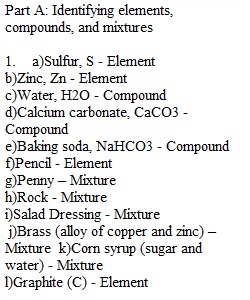


Q Experiment 03 - Physical and Chemical Properties • Points 15 • Submitting a file upload Today we start Experiment 03. You can find a .pdf copy of the Experiment in the Laboratory Manual Module. This lab is considered a "wet lab", as we use chemical equipment and glassware found in the lab room. The lab is designed to give you all practice with several important concepts we cover in Chapter 3: • The difference between elements, compounds, homogenous and heterogeneous mixtures • Measurement of water solubility - a physical property • The difference between physical and chemical changes • Observational evidence of chemical change We cannot meet in the lab room, so you'll be completing this lab using the virtual "data" provided in the .pdf document below. In Part A, use the data give to classify the substances listed as element (E), compound (C), homogenous (Hom) or heterogeneous (Het) mixture. There's a couple of things that can help you make the right classification. • Elements are listed by element name, and include a chemical symbol in their description (look at the procedure). • Compounds are listed by name and chemical formula. • Homogeneous mixtures look even in composition, but are made of 2 or more substances mixed together. • Heterogeneous mixtures are visibly layered. In Part B, we measure water solubility of several substances. Use the data to draw your conclusions. We also look a a couple of physical changes - state change, and mixture formation. In Part C, run several chemical reactions, looking for physical evidence that a chemical change has occurred. Each part of Part C represents a chemical reaction. • The copper wire changes color as the copper atoms react with oxygen, forming a new compound, copper oxide. • The ammonium bicarbonate molecule decomposes when heated into small molecules - water, carbon dioxide, and ammonia (which has a distinct odor) • Vinegar reacts with baking soda and forms carbon dioxide gas as one of the products • The last two reactions occur between compounds dissolved in water that react to form a water insoluble product. All of the "wet lab" experiments this semester have 2 components: The Data Table pages, and the Postlab Questions. You need to complete both parts of the Experiment, and turn them both in as your lab report. Fill out the lab pages and save your work as a .pdf document, and submit your work using the Submit Assignment button at the top of the page. This lab isn't due until Wednesday, June 16 at 10:00 PM. Lab 03 - Observations Actions
View Related Questions